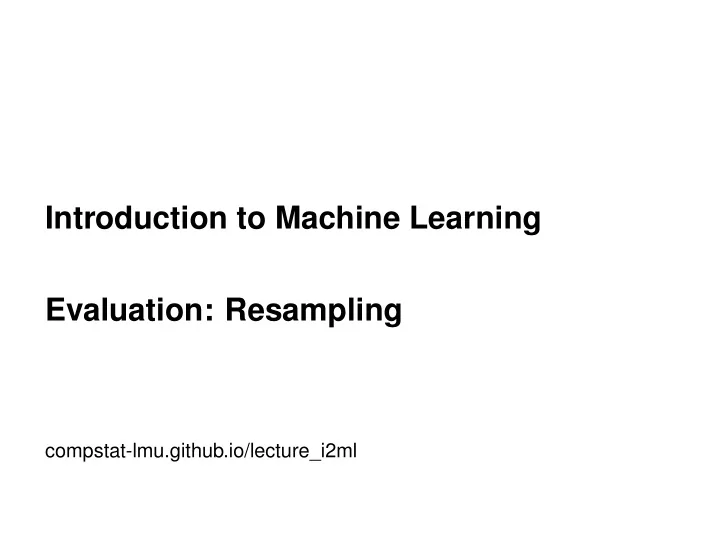

Introduction to Machine Learning Evaluation: Resampling compstat-lmu.github.io/lecture_i2ml
RESAMPLING Aim: Assess the performance of learning algorithm. Make training sets large (to keep the pessimistic bias small), and reduce variance introduced by smaller test sets through many repetitions / averaging of results. Learner Training Dataset Dataset D Model Fit Split into Tain and Test Predict Test Dataset Test Error Repeat = Resample � c Introduction to Machine Learning – 1 / 9
CROSS-VALIDATION Split the data into k roughly equally-sized partitions. Use each part once as test set and join the k − 1 others for training Obtain k test errors and average. Example: 3-fold cross-validation: � c Introduction to Machine Learning – 2 / 9
CROSS-VALIDATION - STRATIFICATION Stratification tries to keep the distribution of the target class (or any specific categorical feature of interest) in each fold. Example of stratified 3-fold Cross-Validation: Class Distribution Iteration 1 Iteration 2 Iteration 3 � c Introduction to Machine Learning – 3 / 9
CROSS-VALIDATION 5 or 10 folds are common k = n is known as leave-one-out (LOO) cross-validation Estimates of the generalization error tend to be pessimistically biased size of the training sets is n − ( n / k ) < n ) bias increases as k gets smaller. The k performance estimates are dependent, because of the structured overlap of the training sets. ⇒ variance of the estimator increases for very large k (close to LOO), when training sets nearly completely overlap. Repeated k -fold CV (multiple random partitions) can improve error estimation for small sample size. � c Introduction to Machine Learning – 4 / 9
BOOTSTRAP The basic idea is to randomly draw B training sets of size n with replacement from the original training set D train : D train D 1 train D 2 train . . . D B train We define the test set in terms of out-of-bag observations D b test = D train \ D b train . � c Introduction to Machine Learning – 5 / 9
BOOTSTRAP Typically, B is between 30 and 200. The variance of the bootstrap estimator tends to be smaller than the variance of k -fold CV. The more iterations, the smaller the variance of the estimator. Tends to be pessimistically biased (because training sets contain only about 63 . 2 % unique the observations). Bootstrapping framework allows for inference (e.g. detect significant performance differences between learners). Extensions exist for very small data sets, that also use the training error for estimation: B632 and B632+. � c Introduction to Machine Learning – 6 / 9
SUBSAMPLING Repeated hold-out with averaging, a.k.a. monte-carlo CV Similar to bootstrap, but draws without replacement Typical choices for splitting: 4 / 5 or 9 / 10 for training Learner Training Dataset Dataset D Fit Model Split into Tain and Test Predict Test Dataset Test Error Repeat = Resample The smaller the subsampling rate, the larger the pessimistic bias. The more subsampling repetitions, the smaller the variance. � c Introduction to Machine Learning – 7 / 9
RESAMPLING DISCUSSION In ML we fit, at the end, a model on all our given data. Problem: We need to know how well this model performs in the future, but no data is left to reliably do this. ⇒ Approximate using holdout / CV / bootstrap / resampling estimate But: pessimistic bias because we don’t use all data points Final model is (usually) computed on all data points. � c Introduction to Machine Learning – 8 / 9
RESAMPLING DISCUSSION 5CV or 10CV have become standard Do not use Hold-Out, CV with few iterations, or subsampling with a low subsampling rate for small samples, since this can cause the estimator to be extremely biased, with large variance. If n < 500, use repeated CV A D with |D| = 100 . 000 can have small sample properties if one class has few observations Research indicates that subsampling has better properties than bootstrapping. The repeated observations can can cause problems in training. � c Introduction to Machine Learning – 9 / 9
Recommend
More recommend